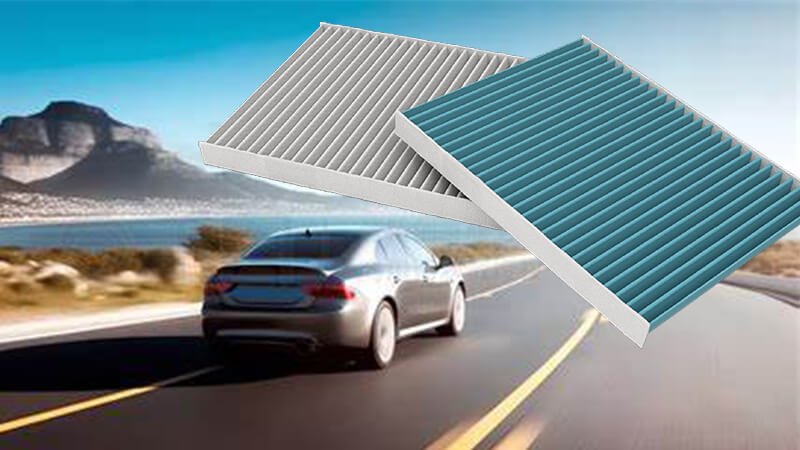The air inside your car’s cabin is essential for comfort and health, but have you ever wondered whether it's clean and safe to breathe? Ensuring that the air entering your vehicle is filtered can make a significant difference in your driving experience. So, is the air getting into your car cabin properly filtered? Let’s explore the role of the cabin air filter.
The cabin air filter plays a crucial role in keeping the air inside your car free from pollutants, allergens, and unpleasant odors. If neglected, it can cause reduced airflow, musty smells, and even health issues. Regularly replacing the cabin air filter is essential for maintaining the air quality in your vehicle.
Now that we understand the importance of a clean cabin air filter, let’s dive deeper into how the air actually enters the cabin and how the filter works to keep it clean.

Does the AC Go Through the Cabin Filter?
Many people rely on their vehicle’s air conditioning (AC) to provide a comfortable atmosphere inside the cabin. But have you ever wondered if the AC system itself uses a filter? Let's take a look at how the AC system and the cabin filter work together.
Yes, the air conditioning system does pass air through the cabin filter. The cabin filter cleans the air before it reaches the cabin, ensuring that the air entering your car through the AC system is free from dust, pollen, and other contaminants.
The cabin air filter serves a vital function by filtering the air that enters the cabin through the vehicle's ventilation system. This includes the air coming through the AC and heating systems. When you activate your car’s AC or heating, the system pulls in air from outside the car. This air must first pass through the cabin air filter, which traps contaminants such as dust, pollen, mold spores, and even vehicle exhaust fumes.
To explain the process more clearly, let’s break down the steps:
-
Air Intake: The HVAC system1 of your vehicle draws air from outside the cabin. The outside air is pulled in through vents located near the grille of the vehicle.
-
Air Filtration: The air passes through the cabin air filter. As it moves through the filter, dust, pollen, pollution, and other airborne particles are trapped, preventing them from entering the cabin.
-
Air Distribution: After filtration, the clean air is then distributed throughout the cabin, either through the AC system or the heating system.
This filtration process ensures that the air inside the cabin is not only cooler in hot weather or warmer in cold weather, but also free of harmful airborne particles. Without the cabin air filter2, your vehicle would be circulating unfiltered air, which could lead to discomfort, health issues, and a less pleasant driving experience.
Table: Comparison of Airflow With and Without Cabin Filter
| Airflow Element | With Cabin Filter | Without Cabin Filter |
|---|---|---|
| Air Quality | Clean, free from dust, pollen, allergens | Contains pollutants, allergens, and dust |
| AC Efficiency | Efficient, maintains airflow | Reduced airflow, less efficient |
| Health Impact | Improved air quality, reduced allergens | Higher exposure to allergens, dust, and pollutants |
| Cabin Odors | Odor-free, fresh air | Musty or unpleasant odors |

Where Does Air Enter the Cabin Air Filter?
Have you ever wondered where exactly the air enters the cabin air filter? Understanding the air intake points can help you appreciate how the filter works and why it’s so important to replace it regularly.
Air enters the cabin air filter through the vehicle’s exterior air intake system. The filter traps airborne contaminants before the air flows into the cabin, ensuring that only clean air reaches you while driving.
The cabin air filter is strategically positioned to filter the air entering the cabin. Here's a detailed breakdown of how air enters the cabin filter:
-
External Air Intake: The primary source of the air entering the cabin comes from the outside environment. This air is pulled into the vehicle’s HVAC system through the external intake system. The intake vents are typically located near the windshield and are designed to capture air as the car moves forward.
-
Cabin Filter Positioning: The intake air flows directly into the cabin air filter3. In most vehicles, the cabin filter is positioned behind the glove box, under the dashboard, or beneath the windshield wipers. The placement ensures that the filter can effectively capture contaminants before they enter the cabin.
-
Filter Efficiency4: Once the air enters the cabin air filter, it is cleaned by the filter’s fibers. Depending on the type of filter, it will trap different sizes of particles. For instance, a high-efficiency particulate air (HEPA) filter can trap smaller particles compared to a standard paper filter.
-
Filter Obstructions: A clogged or dirty filter5 can restrict airflow, meaning that less air reaches the cabin. This can cause the HVAC system to work harder, reducing overall efficiency. It can also lead to unpleasant smells, as trapped particles begin to decompose.
Table: Typical Airflow Pathway through the Cabin Filter
| Step | Description | Potential Issue |
|---|---|---|
| Step 1: Air Intake | Air is drawn from outside the vehicle through intake vents | Blocked intake vents due to debris can reduce airflow |
| Step 2: Passing Through the Filter | Air passes through the cabin air filter, where pollutants are trapped | Clogged filter reduces airflow and filtration efficiency |
| Step 3: Clean Air Circulation | Cleaned air is distributed inside the cabin via the HVAC system | Reduced airflow causes discomfort and lower efficiency |

Does Outside Air Go Through the Cabin Air Filter?
If you’ve ever thought about how the air gets into the cabin, you may have questioned whether it comes from the outside. Let's explore how outside air passes through the cabin air filter and the importance of this process.
Yes, outside air does pass through the cabin air filter. This filter is designed to clean the air from the outside environment before it enters the vehicle’s cabin, ensuring that the air you breathe is free of harmful particles.
The cabin air filter serves as the first line of defense against outside air contaminants. As outside air enters the vehicle through the HVAC system, it passes through the cabin air filter to ensure that only clean, filtered air circulates inside the cabin.
Here’s a breakdown of how the outside air moves through the filter:
-
Air Drawn from the Outside: Outside air is drawn into the vehicle through the intake vents located near the front of the vehicle, often behind the grille. These vents are designed to capture as much fresh air as possible while the vehicle is in motion.
-
Filtration Process: Before the outside air can enter the cabin, it must pass through the cabin air filter6. This filter is typically made from materials such as activated charcoal, pleated paper, or other media designed to trap particles of dust, pollen, mold, and even some odors.
-
Clean Air Circulation: After passing through the filter, the air is clean and free from contaminants, and it is then circulated throughout the cabin. This process ensures that you breathe in only the filtered air from the outside environment, which is especially important for allergy sufferers and individuals with respiratory issues.
-
Filter Maintenance: Over time, the filter becomes clogged with particles and debris. As the filter gets dirtier, it becomes less efficient, reducing the amount of air entering the cabin and diminishing the overall air quality. A clogged cabin filter may also allow some pollutants to sneak through, making the cabin air less clean.
Table: Air Filtration Process for Outside Air
| Stage | Description | Effect of Clogged Filter |
|---|---|---|
| Step 1: Outside Air Intake | Air is pulled from outside the vehicle via intake vents | Reduced airflow, less fresh air |
| Step 2: Filtration | Air passes through the cabin air filter and is cleaned of pollutants | Particles bypass the filter and enter the cabin |
| Step 3: Clean Air Flow | Clean air circulates into the cabin, providing fresh air to passengers | Increased allergens and pollutants inside the cabin |

How Does Air Get into the Car Cabin?
Now that we know the importance of the cabin air filter, how exactly does air flow into your car’s cabin? Let’s break down the entire process and understand how air circulates through your vehicle.
Air enters your car cabin primarily through the ventilation system, which draws air from outside and circulates it through the cabin. The cabin air filter plays a key role in ensuring that this air is clean and free from pollutants.
The process of air entering the car cabin begins when the vehicle’s HVAC (Heating, Ventilation, and Air Conditioning) system draws air from the outside environment. This air enters the vehicle through intake vents located at the front of the car, often near the grille or under the windshield.
Once the outside air is drawn in, it passes through the cabin air filter7, which traps contaminants such as dust, pollen, and pollutants before the air enters the cabin. The clean air is then circulated throughout the cabin by the HVAC system8, providing fresh air to the passengers.
If the cabin air filter is clogged or damaged, the airflow9 can be reduced, leading to a decrease in ventilation efficiency. In addition to reduced airflow, a dirty filter can result in unpleasant odors, as mold or mildew may develop on the filter’s surface.
The HVAC system is designed to be as efficient as possible. However, if the filter is clogged, it forces the system to work harder, which can lead to increased energy use and reduced overall performance.
Table: Air Circulation Process in the Car Cabin
| Step | Description | Potential Issue |
|---|---|---|
| Step 1: Outside Air Intake | Air enters through vents and is drawn into the HVAC system | Clogged intake vents reduce airflow |
| Step 2: Filtration | Air passes through the cabin air filter, removing pollutants | Reduced filtration efficiency with a dirty filter |
| Step 3: Clean Air Flow | Clean, filtered air is distributed throughout the cabin | Poor airflow and potential health risks |

Conclusion
In conclusion, the cabin air filter10 plays a vital role in ensuring that the air entering your vehicle is clean and free from pollutants. It filters the outside air before it enters the cabin, preventing harmful particles from circulating inside the vehicle. Regular maintenance and timely replacement of the cabin air filter are essential to maintaining air quality and ensuring the proper functioning of your vehicle's HVAC system.
-
Discover how the HVAC system operates in your vehicle for optimal comfort and air quality. This link offers valuable knowledge. ↩
-
Understanding the role of a cabin air filter can enhance your vehicle's air quality and comfort. Explore this resource for detailed insights. ↩
-
Understanding the cabin air filter's function can enhance your vehicle's air quality and comfort. Explore this resource for detailed insights. ↩
-
Learn how filter efficiency impacts your vehicle's air quality and overall HVAC performance. This knowledge can help you maintain your car better. ↩
-
Discover the consequences of neglecting your cabin air filter. This information is crucial for maintaining a comfortable and healthy driving environment. ↩
-
Understanding the function of a cabin air filter is crucial for maintaining air quality in your vehicle. Explore this link for detailed insights. ↩
-
Understanding the role of a cabin air filter can help you maintain a healthier car environment and improve air quality. ↩
-
Exploring how the HVAC system operates can enhance your knowledge of vehicle comfort and efficiency. ↩
-
Learning about airflow issues can help you troubleshoot and maintain your vehicle's air conditioning system effectively. ↩
-
Know about OEM cabin air filter and get the best products from Runex auto. ↩













